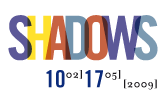
Although the fi rst shadows in art date from the 4th century BC—linked to stage sets and the shading of objects in relief—the cast shadow made its true appearance during the Renaissance. In the 15th century an empirical approach was taken to it, while a century later it was closely associated with perspective. The result of placing a solid, opaque body between a source of light and a surface for projection, the shadow became the subject of experimentation by artists like Gentile da Fabriano, Giovanni di Paolo, Pier Maria Pennacchi, Lorenzo Lotto and the Master of the Magdalen Legend. The positive symbolic connotations of the shadow can also be seen in depictions of the Annunciation. Thus, in paintings by Jan van Eyck, Lorenzo di Credi and Ludovico Carracci, the opaque refl ection of the Angel or the Virgin Mary is an allusion to the ‘shadow of the Almighty’ whose power works the miracle of the Incarnation.

Gentile da Fabriano (c. 1370-1427)
Saint Francis Receiving the Stigmata, 1419
Tempera on panel, 87 x 64 cm
Fondazione Magnani Rocca, Mamiano di Traversetolo, Parma
© 1999. Photo Scala, Florence

Jan van Eyck (c. 1390-1441)
Diptych of the Annunciation, c. 1433-1435
Oil on panel, 38.8 x 23.2 cm (left panel); 39 x 24 cm (right panel)
Museo Thyssen-Bornemisza, Madrid

Lorenzo di Credi (c. 1459-1537)
Annunciation, c. 1480-1485
Tempera on panel, 88 x 71
Galleria degli Uffizi, Florence. Instituti Museali della Soprintendenza
Speciale per il Polo Museale Fiorentino
© 1990. Photo Scala, Florence - courtesy of the Ministero Beni e Att. Culturali

Pier Maria Pennacchi (1464-1514/1515)
The Redeemer Blessing, c. 1500
Oil on panel, 138 x 67 cm
Su concessione del Ministero per i Beni e le Attività Culturali -
Galleria Nazionale di Parma
















